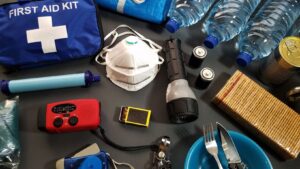Hunting is an ancient and vital activity that requires the hunter not only knowledge and skills but also a responsible attitude towards nature. By doing this activity, we have a great responsibility towards the ecosystem and biodiversity.
We can preserve the natural balance and wildlife populations by preventing overshooting and illegal hunting. However, to ensure the safety and success of hunting, it is important to remember several essential aspects. In this article, we’ll analyze some of the critical elements of a hunting checklist that will help you head out on the hunt prepared and knowledgeable.
The success of your hunt will undoubtedly depend on the quality of your preparation, both morally and physically, because hunting is a rather complex process in which you should show maximum strength and endurance. And also from the training and equipment you take on the hunt. Therefore, use the checklist to ensure you take everything you need and be ready for any eventuality.
Table of Contents
Obtaining a license and knowing the rules of hunting
Getting a permit before hunting is a legal and mandatory step. A key is a document issued by the competent authorities which grants the right to hunt certain species of animals and defines the rules, restrictions, and terms of hunting.
The license allows you to control hunting and limit the cleaning of wild animal populations. It also funds conservation and natural resource management programs. The procedure for obtaining a license can vary depending on the region but usually includes filling out an application, paying the appropriate fee, and completing mandatory training.
Knowledge of hunting regulations is critical to ensuring safety, compliance with the law, and supporting sustainable management of natural resources. This includes rules regarding the types of animals that can be hunted, the number of animals harvested, the size and type of weapons selected, and other restrictions.
Knowing the rules also helps to avoid accidents and unintentional injuries. Safety measures, including properly handling weapons and equipment, are also included in hunting regulations.
Remember that ignorance of the rules does not exempt you from responsibility before the law. To comply with hunting regulations, contact your local regulatory authorities and familiarize yourself with official information and training materials. Your knowledge and actions affect nature’s long-term sustainability and biodiversity, so they must always be at their best. Hunting can be fun, but it also carries a great responsibility to natureand future generations.
Preparation of equipment and safety equipment
Preparing equipment and safety equipment is a crucial step before hunting. It is essential to consider various aspects that can affect the successful outcome of the hunt and ensure safety in the field.
Weapons:
One of the most important aspects of hunting is choosing the right gun. Depending on the type of animal you plan to hunt, you should choose a rifle or shotgun with the necessary caliber and range. Ensure your firearm is adequately maintained and in good condition before pursuing it. Always follow safety rules when handling weapons.
Night Vision Device:
Night vision devices can make hunting in low visibility conditions such as night or early morning much more accessible. Night vision devices allow the hunter to see wildlife in the dark, providing more opportunities to capture prey.

Lures: Using the right tricks and traps can increase your chance of catching prey. Choose baits that match the type of animal you are hunting and learn how to use them properly.
Binoculars and telescope: Binoculars and a telescope can help identify targets at a distance and for detailed observations. They will help you identify wild animals and assess their size and behavior before shooting.
Safety measures: Safety measures must be considered. A life jacket, a portable first aid kit, food and water supply, and means for starting a fire should always be at hand. Communicating with other hunters or rescue services using communication tools is also essential.
Clothes and shoes for hunting
Clothing and shoes for hunting play an essential role in this activity’s comfortable and successful conduct. Not only do they keep you safe and comfortable, but they can also affect your effectiveness as a hunter. Therefore, the choice of clothes and shoes requires special attention and reasoning.
Waterproof clothing:
Hunting often requires being in conditions where you may encounter rain or boggy ground. Waterproof clothing will help you stay dry and comfortable in any weather. This clothing may include a waterproof jacket and trousers.
Warm clothes:
Choose clothes that will keep you warm depending on the season and climatic conditions. In winter, it can be an insulated jacket and pants. It is also important to consider layers of clothing to regulate body temperature quickly.
Camouflage:
Camouflage clothing allows you to remain undetected and get closer to wildlife. Choose a mask that matches the local environment where you are hunting.
Headgear and gloves:
Headgear such as a hat or balaclava will help keep your head warm. Gloves are essential to protect hands from cold and damage.
Footwear:
Choosing the proper footwear is a crucial aspect. Choose waterproof and wear-resistant boots with an excellent soles for good traction on various surfaces. Shoes should be comfortable for long walks and resistant to excessive wear.
Accessories:
Some useful accessories include scarves, binoculars, and flashlights. These things can help you spend time in nature more comfortably and efficiently while hunting.

Remember that clothes and shoes for hunting should not only be practical but also meet safety requirements. With the right fit, they will help you enjoy the outdoors while staying dry, comfortable, and invisible to wildlife while keeping other hunters safe.
Hunting is an activity that requires a responsible approach and knowledge. The checklist in this article addresses all aspects of preparation and safety measures that will increase your chances of a successful and safe hunt. Regardless of your experience, always remember that safety and hunting ethics are essential aspects of this activity and should always come first.




